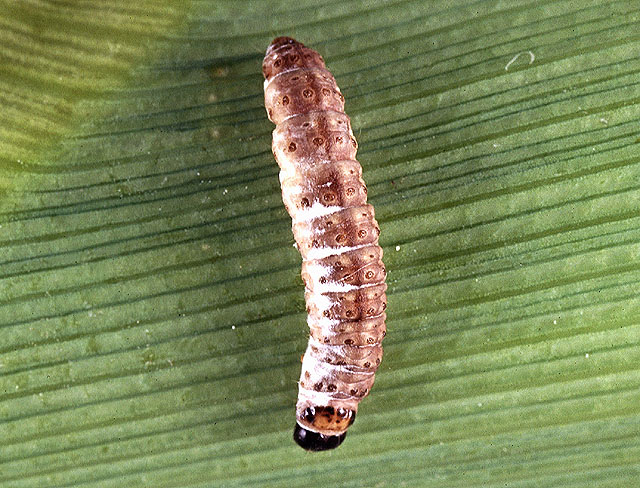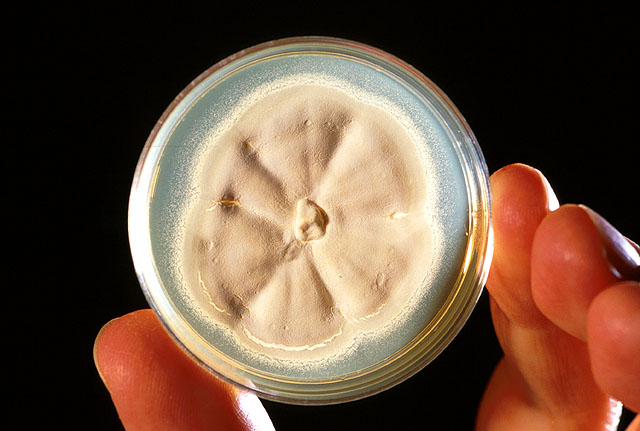Pitting Good Versus Bad Fungi on Sweet Corn: A Delicate Dance
Contact: Jan Suszkiw
Email: Jan.Suszkiw@usda.gov
September 30, 2024
The same defenses that help some varieties of sweet corn resist fungal diseases can also stymie the potency of a beneficial fungus used to kill hungry caterpillar pests, studies by Agricultural Research Service (ARS) scientists suggest.
Entomologist Pat Dowd and Molecular Biologist Eric Johnson—both at the ARS National Center for Agricultural Utilization Research in Peoria, Illinois—conducted the study as a follow up to one they did in 2022 with field (dent) corn, which is grown for livestock consumption and other uses.
Results from the 2022 study indicated resistance to fungi that cause Fusarium disease in some lines of field corn can diminish the effectiveness of the beneficial fungus Beauveria bassiana, which can be sprayed onto the crop as a biopesticide that kills caterpillar pests such as European corn borers and fall armyworms.
However, not all of the Fusarium-resistant dent corn lines tested had a corresponding decline in the Beauveria fungus’s caterpillar-killing performance. Some corn lines also withstood the insect pests’ feeding damage, leaving open the possibility these lines carried the right combination of genes for benefiting from both disease resistance and compatibility with Beauveria.
 Caterpillar stage of European corn borer infected with the beneficial fungus Beauveria bassiana. (Photo by Keith Weller)
Caterpillar stage of European corn borer infected with the beneficial fungus Beauveria bassiana. (Photo by Keith Weller)
Follow-up studies with sweet corn reflect a similar possibility with respect to the genes they possess, according to Dowd and Johnson. In those studies, biopesticide applications of Beauveria killed 12 to 58 percent of European corn borer and fall armyworm caterpillars. However, as with dent corn, the level of insecticidal activity depended on which of 14 lines of Fusarium-resistant hybrid or inbred sweet corn had been treated. In some sweet corn lines, for example, signs of high levels of disease resistance in the form of smaller dead spots on Fusarium-infected leaves were associated with increases in the percentage of caterpillars killed by the fungus two days after application. In other types of sweet corn that were less resistant, larger dead spots corresponded to lower levels of caterpillar control.
Caterpillar control also varied depending on which of two Beauveria strains were used, an observation that underscores the need for continued study on how these subtleties can translate to practical data growers can use in choosing sweet corn lines offering both Fusarium resistance and high levels of insecticidal activity using the beneficial fungus.
 Culture of the beneficial fungus Beauveria bassiana. (Photo by Keith Weller)
Culture of the beneficial fungus Beauveria bassiana. (Photo by Keith Weller)
Finding that “sweet spot” in sweet corn would be especially important to organic growers, who cannot use synthetic pesticides and have fewer options for disease and insect control than in conventional production systems.
“The results of gene expression studies comparing sweet corn hybrids with more and less desirable combinations of Fusarium resistance and Beauveria efficacy were recently received,” said Dowd. “These results will help identify favorable combinations of genes that will help guide the breeding of sweet corn varieties to produce ones that have good resistance to Fusarium and are more compatible with the use of Beauveria.”
The researchers detailed their findings in the January 2024 issue of the journal Organic Agriculture.
The Agricultural Research Service is the U.S. Department of Agriculture's chief scientific in-house research agency. Daily, ARS focuses on solutions to agricultural problems affecting America. Each dollar invested in U.S. agricultural research results in $20 of economic impact.
